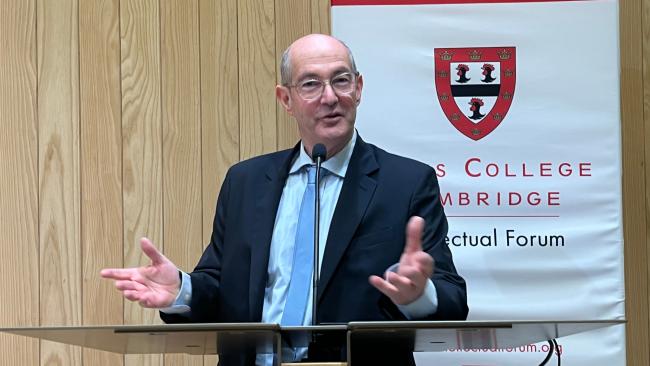
Why multidisciplinary responses to climate change are vital for global aviation
Geography student Harvey Logan (2019) has won the College's essay writing competition for first year undergraduates. The students were set the following challenge, which Harvey answers below.
"I would describe my essay as an explanation of why multidisciplinary responses to climate change are so vital for global aviation, and a discussion of some of the decarbonisation initiatives currently being explored by the industry. Although I don't yet have any certainty about what to do in the future, I hope to work in the aviation/transport sector." Harvey Logan
"Climate change requires multidisciplinary responses and multifaceted solutions". Discuss this statement and suggest potentially actionable and innovative solutions.
The topic of responding to climate change is extraordinarily broad and would be impossible to cover in limited words, therefore this essay will focus solely on the aviation sector. The climate impact of the aviation industry is particularly pertinent as for most individuals it is the single largest contributor to the carbon intensity of their lifestyles. Alongside this, aviation is one of the hardest industries to decarbonise, due to the rigorous airworthiness and safety standards which apply, and the demand for engineering reliability in harsh environments (IPCC, 2007). This makes it an interesting case study to show the need for innovation and multidisciplinary approaches to adequately respond to the global climate crisis. This essay will first consider the wider climate impacts of aviation in context of the benefits which aviation brings, before moving on to discuss potential solutions to ensure aviation’s future sustainability, concluding that a multifaceted and multidisciplinary approach is needed for this to be done with any success.
The most obvious way in which aviation impacts upon the climate is through the release of CO₂. Currently, 2-2.5% of global CO₂ emissions come from aircraft (AEF, 2019). The warming effect of increased atmospheric CO₂ is well documented and a clear cause for concern. On top of this, aircraft also emit other greenhouse gasses including NOₓ, O₃ and CH₄, the warming effects of which are magnified by the fact they are emitted at high altitude. Increases in concentrations of these gases in the troposphere - the cruising altitude of most modern airliners - are more effective at increasing radiative forcing than increases at lower altitudes (IPCC, 1999). Additionally, emissions of water vapour and the formation of contrails contributes to the radiative effect, in some scenarios causing the formation of extensive cirrus clouds. Aircraft induced cirrus clouds are estimated to cover up to 0.2% of the earth’s surface at any given time (IPCC, 1999). The impact of aviation emissions on climate warming is therefore 2-4 times larger than the impact of its CO₂ emissions alone (IPCC, 1999). This makes the sector responsible for up to 5% of annual climate warming (Bannon, 2018). From these figures the imperative for aviation to reduce its emissions to prevent runaway climate change is clear, however it is important to remember that the process of flying which causes these emissions has in other ways benefited humanity immensely. Aviation supports 65.5 million jobs worldwide, 3.6% of global GDP and has a global economic impact of $2.7 trillion (ATAG, 2018). Growth in air travel has been linked to its ever-increasing affordability, with low cost airlines making up a large proportion of this expansion. This has allowed populations to benefit from unprecedented levels of mobility, including those who may not have had the chance to fly were it not for cheap airfares. A study of small airports in the EU showed that incoming passengers would spend on average €285 each and generate up to €272 million for communities which otherwise would be relatively poorly connected (Macario, Viegas, & Reis, 2008). Furthermore, the continued ability to fly is vital to small island states and remote communities, as well as for the development of emerging economies in Africa and Asia and the alleviation of poverty. This shows the need to develop innovative climate solutions which will allow these benefits to continue without any negative impact on the environment.
The highest profile approach which the aviation industry is using to combat its climate impact is through carbon offsetting. The International Civil Aviation Organisation’s CORSIA scheme will require airlines to publish emissions data annually and buy offsets for these emissions (IATA, 2019). As well as contributing to offsetting, this scheme incentivises decarbonisation by creating an additional cost for carbon in much the same was as a ‘carbon tax’ (Warwick & Norris, 2019). Despite these positives, the CORSIA scheme faces numerous criticisms for being too limited in its scope, not harsh enough on emitters and being implemented too slowly (Pavlenko, 2018). The debate around the CORSIA scheme highlights the need for a multidisciplinary response, as political objections must be weighed up against business cases and engineering possibilities, with a huge variety of disciplines eventually having a role in the final solution. The need for a multifaceted approach can also be explored here. CORSIA alone could never absolve aviation’s responsibility for high levels of emissions, and thus a range of other approaches to decarbonisation must simultaneously be followed. ‘Flight shaming’ has become increasingly popular in the last year, especially in Europe, with a survey by UBS finding that 21% of people have already reduced the number of flights they take (Coffey, 2019). This citizen led approach towards climate activism creates additional pressures on airlines to begin the process of decarbonisation through investment in new technology, and on policy makers to assist in allowing a modal shift in transportation to less carbon intensive options where available.
A multidisciplinary approach goes hand in hand with innovation. There is a significant amount of technology development in the aviation sector which will allow for some decarbonisation. Electric aircraft are already a reality for small commuter airlines. Canada’s Harbour Air is planning to install 750hp MagniX electric motors into the bodies of its existing aircraft, replacing the conventional gas turbine (Zart, 2019) with the aircraft ready to enter service in 2020 (Harbour Air, 2019). Other airlines interested in small electric aircraft include Scotland’s Loganair, Norway’s Wideroe, and Cape Air of Massachusetts, who will be the launch customer of the Eviation Alice, a new build all-electric airliner (Reid, 2019). Other ongoing research includes Airbus’ E-fanX research into electric propulsion (Airbus, 2019) and UTC project 804 designing a hybrid motor to be fitted to current generation mid-sized aircraft (United Technologies, 2019). Despite the potential for small electric aircraft to fly short distances, large long-haul aircraft will still require liquid, energy dense fuel like kerosene. Here we see again the necessity of a multifaceted approach, as electric propulsion cannot act as a solution in all scenarios. Sustainably produced biofuel is likely the most promising way to reduce aviation emissions on larger aircraft, coupled with efficiency gains in conventional technologies, like higher-bypass turbofans or improvements to aircraft architecture to reduce the strain on overall fuel usage. This shows that there is no ‘one-size fits all’ method for responding to climate change, and a vast array of options must be explored.
This is not to say that decarbonising aviation, will be an easy task, it certainly won’t, and in the short-term we will have to make sacrifices including flying less. Political cooperation will be vital, as will cooperation across different economic sectors – it would be no use introducing a fleet of electric aircraft if that electricity is generated by a coal fired powerplant. A multidisciplinary approach drawing on the advice of climate scientists, working with engineers to design solutions, policy makers to support them, airlines to implement them and citizens to provide the appetite for change, does make these solutions seem entirely feasible. This conclusion does not apply solely to aviation, and a multifaceted, multidisciplined approach encompassing a wide range of people and ideas is the only way to generate a satisfactory response to the climate crisis by creating actionable solutions which can then be effectively implemented.
Bibliography
AEF. (2019). Climate Change. Retrieved from Aviation Environment Federation: https://www.aef.org.uk/issues/climate/
Airbus. (2019). E-Fan X. Retrieved from Airbus: https://www.airbus.com/innovation/future-technology/electric-flight/e-fan-x.html
ATAG. (2018). Powering global economic growth, employment, trade links, tourism and support for sustainable development through air transport. Geneva: Air Transport Action Group.
Bannon, E. (2018, February 6). Aviation: 2 to 3 times more damaging to the climate than industry claims. Retrieved from Transport and Environment: https://www.transportenvironment.org/news/aviation-2-3-times-more-damaging-climate-industry-claims
Coffey, H. (2019, October 2). FLIGHT PASSENGER GROWTH COULD HALVE DUE TO ‘FLIGHT SHAME’, SAYS NEW RESEARCH. Retrieved from The Independant: https://www.independent.co.uk/travel/news-and-advice/flight-shame-growth-halve-passengers-flygskam-climate-change-ubs-survey-a9129206.html
Harbour Air. (2019, March 26). Harbour Air and magniX Partner to Build World’s First All-Electric Airline. Retrieved from Harbour Air: https://www.harbourair.com/harbour-air-and-magnix-partner-to-build-worlds-first-all-electric-airline/
IATA. (2019, May 9). CORSIA fact sheet. Retrieved from IATA: https://www.iata.org/pressroom/facts_figures/fact_sheets/Documents/corsia-fact-sheet.pdf
IPCC. (1999). IPCC SPECIAL REPORT: Aviation and the global atmosphere. Cambridge: Cambridge University Press.
IPCC. (2007). Climate Change 2007: Mitigation of Climate Change. Cambridge: Cambridge University Press.
Macario, R., Viegas, J., & Reis, V. (2008, November). Impact of low cost operation in the development of airports and local economies.
Pavlenko, N. (2018, August 6). ICAO’s CORSIA scheme provides a weak nudge for in-sector carbon reductions. Retrieved from International Council on Clean Transpotation: https://theicct.org/blog/staff/corsia-carbon-offsets-and-alternative-fuel
Reid, D. (2019, June 18). All-electric jet firm Eviation announces US regional airline as first customer, predicts delivery in 2022. Retrieved from CNBC: https://www.cnbc.com/2019/06/18/all-electric-jet-firm-eviation-announces-us-airline-as-first-customer.html
United Technologies. (2019, June 17). Project 804: The next step on the path to more electric aviation. Retrieved from United Technologies: https://www.utc.com/en/news/2019/06/17/airshow-p804
Warwick, G., & Norris, G. (2019, February 28). Check Six Podcast. Retrieved from Aviation Week: https://player.fm/series/aviation-weeks-check-6-podcast-62478/can-aviation-do-more-to-combat-climate-change
Zart, N. (2019, October 29). Seaplanes Get Electric With Magnix & Harbour Air. Retrieved from CleanTechnica: https://cleantechnica.com/2019/10/29/seaplanes-get-electric-with-magnix-harbour-air/





